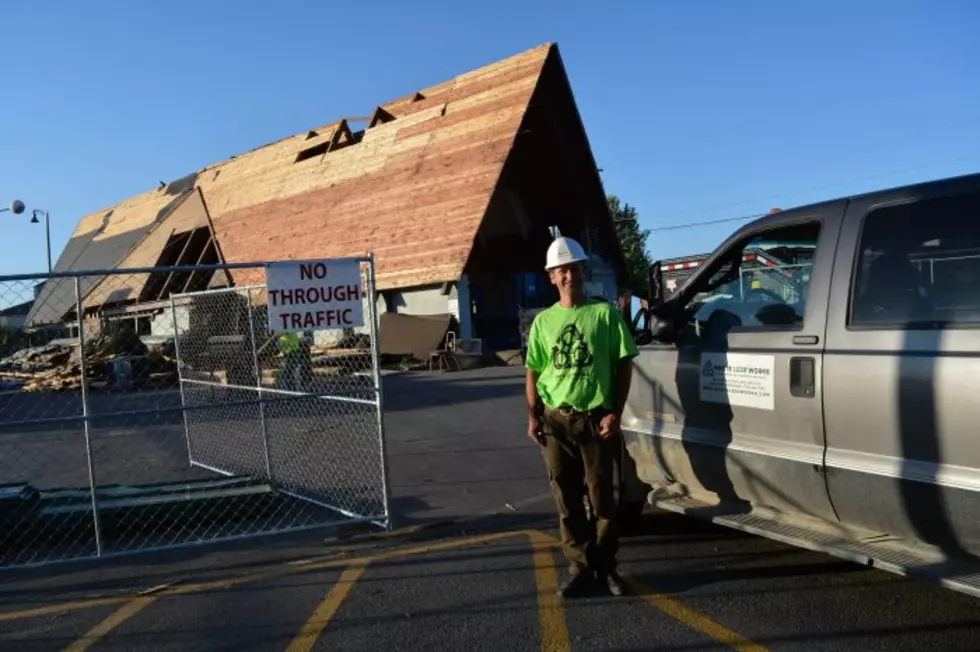
Missoula company recycles buildings, 1 brick at a time
Built in 1973, the king-size A-frame was an International House of Pancakes for many years. More recently, it was the Best Bet Casino. Now it’s being deconstructed piece by piece, and most of it will be salvaged and recycled for use at other construction projects, thanks to the efforts of a Missoula company called Waste Less Works Deconstruction and Material Recovery.
“There’s lots of businesses smashing down buildings – bulldozing them down and trucking it to the landfill -- but not many are recycling them,” said Martin Fahrney, who started Waste Less Works eight years ago. “Most of the material can be used again and, in fact, is of better quality than a lot of stuff you can buy now.”
In academia, deconstruction is a literary and philosophical concept regarding the analytic examination of something to reveal its inadequacy. When it comes to demolishing structures, deconstruction is defined as “construction in reverse” – the process of removing a building by taking it apart in the reverse order of construction, to save and reuse valuable building materials and reduce waste. Fahrney first became interested in deconstruction in an academic environment.
While earning a degree in environmental studies at the University of Montana, Fahrney learned about “embodied energy,” defined as “the energy consumed by all the processes associated with the production of a building, from the mining and processing of natural resources to manufacturing, transport and product delivery.”
Buildings contain a great deal of “embodied energy” and reusable materials, Fahrney said. These materials – such as crown moldings, hardwood floors, bricks, lumber, insulation, leaded windows, doors, windows, cabinets and more -- provide affordable options to homeowners or business owners doing remodels, renovations, or tenant improvements.
Salvaging and reusing can make a significant difference. According the Environmental Protection Agency, companies in the United States generate 136 million tons of building-related construction and demolition waste per year, making up 30-percent of all solid waste produced. More than 90-percent of building-related waste is from renovation and demolition.
“We live in a consumptive, extractive world. We’re all complicit. But we can all learn to reduce, reuse and recycle,” Fahrney said. “I think any community the size of Missoula and bigger, anywhere, can support a deconstruction business.”
After graduating from the university, Fahrney worked for Home ReSource, a nonprofit community sustainability center on Russell Street, as part of their deconstruction crew before eventually starting Waste Less Works. He is also in the process of building his own home, made completely of salvaged and recycled materials.
“I’ve been an environmentalist as long as I can remember,” he said. “I saw it as something I could do without too much specialized training. I learned on the job. The Earth is a really beautiful and sacred place. I see what I do as mining urban waste in an effort to reduce environmental impacts elsewhere and make a dollar while I’m doing it.”
He now employs ten people and keeps busy. Lately, he’s been working 14-16-hour days. In addition to deconstructing the old Best Bet Casino at 3620 Brooks Street, he is remodeling the nearby Missoula Federal Credit Union. (The old Best Bet Casino building, owned by the Woodbury Corp., will soon be replaced with a new AT&T retail store.)
Deconstruction is generally more time consuming than bulldozing a building and hauling it to the landfill. It’s mostly done slowly and cautiously with hand tools to prevent damage to materials. More time equals more costs for the demolitions phase. “I don’t usually make a profit until I sell the material,” Fahrney said. “But there’s a huge demand for the material.”
Waste Less Works takes on commercial and residential jobs, interior and exterior, including large buildings, houses, sheds, garages, barns floors, and removal of walls, carpets, tile, flooring and siding. Salvaged materials acquired from job sites are either sold to the community, typically at a significantly lower price than retail value, or donated to Home ReSource.
Salvaged and recycled material can be purchased at Fahrney’s Salvage and Storage Yard at 2604 Industry Way, between West Broadway and the railroad tracks. Items for sale include lumber, plywood, stone and masonry, flooring, furniture, lighting, doors, windows, hardware, appliances, water heaters and an assortment of other interesting items, including an ATM machine, some rotating barstools, and an historic Charles P. Shipley horse saddle.
As a sign near the entrance states, “Most everything is for sale.”
For more information about Waste Less Works, click here: https://www.wastelessworks.com/
